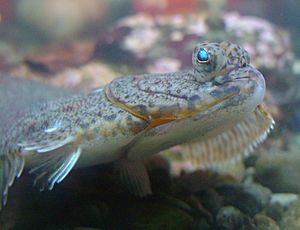American plaice facts for kids
Quick facts for kids American plaice |
|
|---|---|
 |
|
| Scientific classification | |
| Kingdom: | |
| Phylum: | |
| Class: | |
| Order: | |
| Family: |
Pleuronectidae (righteye flounders)
|
| Genus: |
Hippoglossoides
|
| Species: |
H. platessoides
|
| Binomial name | |
| Hippoglossoides platessoides Fabricius, 1780
|
|
The American plaice (scientific name: Hippoglossoides platessoides) is a type of flatfish that lives in the North Atlantic Ocean. It's also sometimes called the American sole or long rough dab. This fish is a member of the flounder family, which means it has both eyes on one side of its head!
Contents
Where American Plaice Live
American plaice are found in the cold waters of the North Atlantic.
- In the northwest Atlantic, you can find them from Greenland and Labrador down to Rhode Island.
- In the northeast Atlantic, they live from Murmansk in Russia all the way to the English Channel, Ireland, and Iceland.
They like to live on soft, sandy, or muddy bottoms deep in the ocean. They are usually found at depths between 90 and 250 meters (about 300 to 820 feet), but they can live much deeper, up to 3,000 meters (almost 10,000 feet)!
What American Plaice Eat
American plaice are not picky eaters! They hunt for their food on the seafloor.
- They enjoy eating sand dollars, which are flat, round sea creatures.
- They also eat brittle stars, which look a bit like starfish.
- Their diet includes small crustaceans (like tiny crabs or shrimp).
- They also eat polychaetes, which are a type of marine worm.
- Sometimes, they even eat smaller fish like capelin and launce.
Life Cycle and Growth
In places like the Gulf of Maine, American plaice usually lay their eggs in April and May. This is called spawning. These fish can grow to be quite large, reaching a maximum length of about 70 centimeters (about 27 inches).
Conservation Status
The American plaice is an important fish in the Atlantic.
- Some groups, like the Northwest Atlantic Fisheries Organization, are concerned that too many of these fish have been caught. They believe the fish population needs time to recover.
- However, the Canadian government believes there are still many American plaice. In fact, it's the second most caught flatfish by Canadian fishermen, making up about half of all flatfish they catch.
- A study from 1997 suggested that American plaice in Canada were at risk because of too much fishing.
- In Europe, this fish is generally common. Fishermen don't usually target them, but they are often caught by accident when fishing for other species.
See Also

